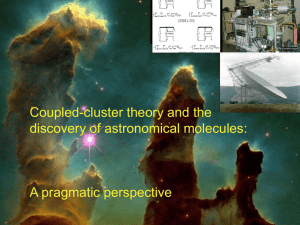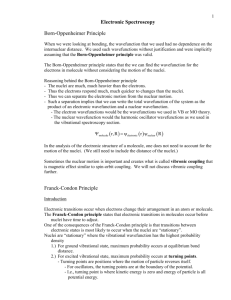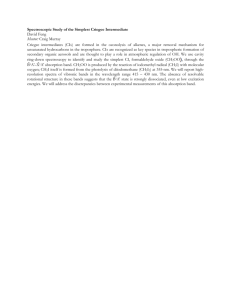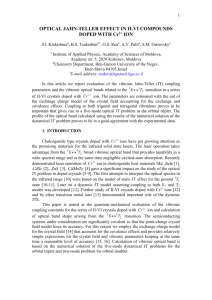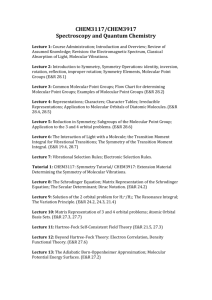CC_vibronic - University of Waterloo
advertisement
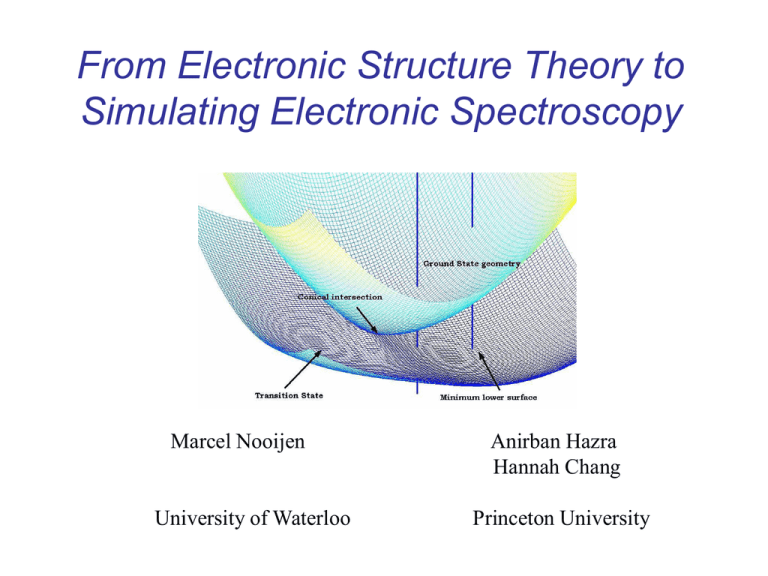
From Electronic Structure Theory to Simulating Electronic Spectroscopy Marcel Nooijen University of Waterloo Anirban Hazra Hannah Chang Princeton University Beyond vertical excitation energies for “sizeable” molecules: (A) Franck-Condon Approach: Single surface (Born-Oppenheimer). Decoupled in normal modes. Computationally efficient. (B) Non-adiabatic vibronic models: Multiple coupled surfaces. Coupling across normal modes. Accurate but expensive. What is best expansion point for harmonic approximation? Second order Taylor series expansion around the equilibrium geometry of the excited state. Accurate 0-0 transition. Excited state PES Second Taylor series expansion around the equilibrium geometry of the absorbing state. Accurate vertical energy. Ground state PES Time-dependent picture of spectroscopy t ex (q, t ) e iH ext Xˆ 0 (q ) Xˆ 0 (q ) P( , T ) T ˆ (q, t ) eit dt ( q ) X ex 0 T 0 (q) The broad features of the spectrum are obtained in a short time T. Accurate PES desired at the equilibrium geometry of the absorbing state. Ethylene excited state potential energy surfaces H CH stretch H C C H H CH2 scissors C H H C=C stretch H C C H H H H H H Torsion C H C H C H Vertical Franck-Condon •Assume that excited state potential is separable in the normal modes of the excited states, defined at reference geometry H ex iHarmonic hˆHarmonic (Qi ) hˆHarmonic n (Qi ) n n (Qi ) jAnharmonic K.E.(Q j ) V (Q j ) hˆAnharmonic n (Q j ) n n (Q j ) i (Qi ) j (Q j ) 1 (Q1 ) 2 (Q2 )... l (Ql ) m (Qm )... i j Harmonic Anharmonic Electronic absorption spectrum of ethylene: Rydberg + Valence state Experiment Geiger and Wittmaack, Z. Naturforsch, 20A, 628, (1965) Calculation Rydberg state spectrum Total spectrum Valence state spectrum Beyond Born-Oppenheimer: Vibronic models • Short-time dynamics picture: P( , T ) T ˆ iHt Xˆ (q) eit dt ( q ) Xe 0 0 ˆ T Requires accurate time-dependent wave-packet in Condon-region, for limited time. Use multiple-surface model Hamiltonian Ĥ that is accurate near absorbing state geometry. E.g. Two-state Hamiltonian with symmetric and asymmetric mode E1 hˆ1 k1 qs Hˆ ka qa ka qa E2 hˆ2 k2 qs Methane Photo-electron spectrum Fully quadratic vibronic model Calculating coupling constants in vibronic model Construct model potential energy matrix in diabatic basis: i ij Vab (q) Ea ab Eab qˆi 12 Eab qˆi qˆ j i i • Calculate geometry and harmonic normal modes of absorbing state. • Calculate "excited" states in set of displaced geometries along normal modes. • From adiabatic states construct set of diabatic states : Minimize off-diagonal overlap: a (q) (0) ca (q) (q) (0) • Obtain non-diagonal diabatatic Vab (q) • Use finite differences to obtain linear and quadratic coupling constants. • Impose Abelian symmetry. Advantages of vibronic model in diabatic basis • "Minimize" non-adiabatic off-diagonal couplings. • Generate smooth Taylor series expansion for diabatic matrix. The adiabatic potential energy surfaces can be very complicated. • No fitting required; No group theory. • Fully automated routine procedure. • Model Potential Energy Surfaces Franck-Condon models. • Solve for vibronic eigenstates and spectra in second quantization. Lanczos Procedure: - Cederbaum, Domcke, Köppel, 1980's - Stanton, Sattelmeyer: coupling constants from EOMCC calculations. - Nooijen: Automated extraction of coupling constants in diabatic basis. Efficient Lanczos for many electronic states. Vibronic calculation in Second Quantization 1 ˆ TN ki qi2 0 ibi†bˆi 2 i i 1 ˆ ˆ† qˆi (bi bi ) 2 • 2 x 2 Vibronic Hamiltonian (linear coupling) E1 0 ˆ H 0 , ibˆi†bˆi 11i qˆi 0 12i qˆi i † i ˆ ˆ E2 0 i 12 qˆi ibi bi 22 qˆi • Vibronic eigenstates a ,i , j ,...,m cia, j ,...,m ni , n j ,..., nm a • Total number of basis states M i M j ...M m N a • Dimension grows very rapidly (but a few million basis states can be handled easily). • Efficient implementation: rapid calculation of HC Ethylene second cationic state: PES slices. torsion CC=0.0 CH2 rock, CC=0 CC stretch torsion CC=2.0 CH2 rock, CC=-1.5 Vibronic simulation of second cation state of ethylene. Simulation includes 4 electronic states and 5 normal modes. Model includes up to quartic coupling constants. (Holland, Shaw, Hayes, Shpinkova, Rennie, Karlsson, Baltzer, Wannberg, Chem. Phys. 219, p91, 1997) Issues with current vibronic model + Lanczos scheme • Computational cost and memory requirements scale very rapidly with number of normal modes included in calculation. • For efficiency in matrix-vector multiplications we keep M i M j ....M N a basis states (no restriction to a maximum excitation level) • Vibronic calculation requires judicious selection of important modes, which is error prone and time-consuming. What can be done? Transformation of Vibronic Hamiltonian Hamiltonian in second quantization: ˆ ˆ† ˆj Hˆ Eba aˆ †bˆ Ebjai aˆ †bi ˆ ˆ† E a aˆ †bi ˆ ˆ E aij aˆ †bi ˆ ˆ† ˆj † E a aˆ †bij ˆ ˆˆ Ebai aˆ †bi bi b bij Electronic states a, b ; a †b a b Normal mode creation and annihilation operators iˆ† , ˆj Unitary transformation operator eTˆ † eTˆ T T G e He Define Hermitian transformed Hamiltonian Find operator T̂ , such that Ĝ is easier to diagonalize … Details on transformation • “Displacement operators” iˆ† iˆ pˆ ˆ ˆ† bˆ†ai ˆ ˆ† ˆj † bˆ†aji ˆ ˆ) tbaij (aˆ †bi ˆˆˆ) Tˆ tbai (aˆ †bi ˆ ˆ Tˆ Hˆ eT He • hbai hbaij haib hajib 0 ˆ† j ˆj †i Lij i “Rotation operators” ai † † † † i) U uba ( a †b b†a) ubj ( a bi j b aj ˆ ˆ ˆ Uˆ ; ˆ Tˆ eUˆ eUˆ † He Gˆ eU eT He gba 0, a b, gbjai 0, except (a b, i j ) • After solving non-linear algebraic equations: ai † † i G gaa a †a gai a ai .... Adiabatic, Harmonic!? We are neglecting three-body and higher terms in Ĝ Eigenstates and eigenvalues of Ĝ : Gˆ n, a En ,a n, a ˆ Tˆ eUˆ n, a E eTˆ eUˆ n, a He n ,a n,a : original oscillator basis, En ,a harmonic Transition moments: ˆ Tˆ eUˆ n, a n, a eUˆ eTˆ Xˆ 0 0 Xe Easy calculation of spectrum after transformation. Akin to Franck-Condon calculation. # of parameters in Tˆ ,Uˆ scales with # of normal modes Additional approximations: • Assume Aˆ ,Tˆ is a two-body operator, if  is two-body. Reasonable if T̂ is small a ,i i Exact if tb abt (coordinate transformation) • Allows recursive expansion of infinite series 1 Gˆ Hˆ Hˆ ,Tˆ Hˆ ,Tˆ ,Tˆ ... 2 • Method is “exact” for adiabatic harmonic surfaces (including displacements & Duschinsky rotations). • Unitary expansion does not terminate, but preserves norm of wave function. • [ Transformation with pure excitation operators can yield unnormalizable wfn’s Similarity transform changes eigenvalues Hamiltonian!! ] Example: Core-Ionization spectrum ethylene Exact / Transformed Spectrum H H C* H H C H C H H C* H Potential along asymmetric CH stretch Franck-Condon spectrum Analysis core-ionization spectra Localized core-hole Basis l,r: Delocalized core-hole Basis g, u: Eg hˆ0 ksˆ aˆ ˆ aˆ Eu h0 ksˆ E hˆ0 ksˆ aˆ E / 2 ˆ E / 2 E h0 ksˆ aˆ In localized picture: Displaced harmonic oscillator basis states ns , na , l , ns , na , r , E nss naa Diagonalize 2x2 Hamiltonian E nss naa E / 2 Same frequencies as in ground state (very different from FC) Transformation works in delocalized picture. Slightly different frequencies. Symmetric mode coupling is the same in the two states. Core Ionization Spectrum acetylene H * C C H H C * C Exact Lanczos / Transformation Perfect agreement Exact /Transformed H Individual states: exact Lanczos Franck-Condon spectrum Benzene Core ionization Transformation with 6 electronic states, 11 normal modes ‘Breakdown’ of transformation method for strongly coupled E1u mode at 1057 cm-1 Combined Transform – Lanczos approach • Identify "active" normal modes that would lead to large / troublesome transformation amplitudes. • Transform to zero all ‘off-diagonal’ operators that do not involve purely active modes. • Solve for ,U and obtain a transformed Hamiltonian: ˆ ˆ ˆUˆ Gˆ eU ˆ He • Obtain n, a eUˆ ˆ Xˆ 0 as starting vector Lanczos • Perform Lanczos with the simplified Hamiltonian Ĝ . Example: strong Jahn-Teller coupling Transformation Active / Lanczos Full Lanczos vs Full Transform Full Lanczos vs Partial Transform Summary • Vibronic approach is a powerful tool to simulate electronic spectra. • Coupling constants that define the vibronic model can routinely be obtained from electronic structure calculations & diabatization procedure. • Full Lanczos diagonalizations can be very expensive. Hard to converge. • Vibronic model defines electronic surfaces: Can be used in (vertical and adiabatic) Franck-Condon calculations. No geometry optimizations; No surface scans. Efficient. • “Transform & Diagonalize” approach is interesting possibility to extend vibronic approach to larger systems. Anirban Hazra Hannah Chang Alexander Auer NSERC University of Waterloo NSF
